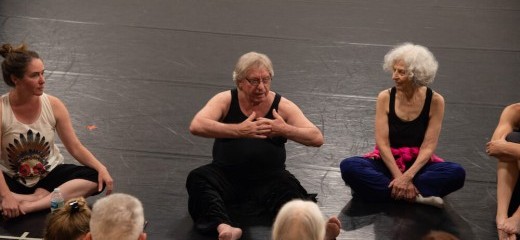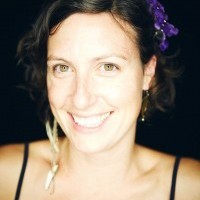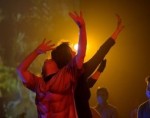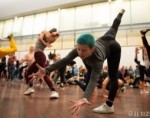
Being Moved: Honoring Manfred Fischbeck (1940-2021)
by Megan Bridge*
Manfred Fischbeck was the co-founder, artistic and executive director of Group Motion Multi Media Dance Theater in Philadelphia. For more than 50 years, he was a vital force of the Philadelphia arts community, performing, composing, teaching, choreographing, and touring with Group Motion locally, nationally, and internationally. March 17 marked the end of Manfred’s journey on earth and his transition into another realm. He died of a ruptured aortic aneurysm at Penn Presbyterian Medical Center.
Manfred left an indelible mark on generations of Philadelphia dancers and performers.
Group Motion’s arrival on the Philadelphia dance scene in 1968 established the ground conditions that allowed experimental performance to thrive in our city for the next five decades. The company’s work in multimedia performance, collective authorship, and improvisation blazed a path for future generations of artistic boundary-pushers.
Manfred taught student dancers and actors at University of Pennsylvania (from 1976) and University of the Arts (from 1985) until his death. With Group Motion’s co-founder and co-director Brigitta (Gitta) Herrmann, he created and led the legendary Group Motion Workshop, held every Friday night in Philadelphia since 1971 (now on Zoom and in outdoor spaces, led solely by Brigitta). Open to all, this 90-minute weekly movement ritual accompanied by live music begins with a guided breathing meditation, progressing to a practice of structures and games that engender movement expression, group communication, and play.
While his life’s work and vision were focused on “practicing movement as a means to living an expressive and gratifying life,”** Manfred only began dancing at the age of 28. Born to German missionary parents in Tanzania in 1940, Manfred returned to war-torn Stendal, East Germany, with his family when he was 4. He grew up surrounded by music, singing Bach in various choirs, studying violin and piano. At 14, he defected to West Berlin, attending a boarding school for East German refugees, and later, from 1959 to 1967, studying literature, philosophy, and theater at the Free University of Berlin. Manfred lived “rebelliously with [his] communal family of friends and artists, engaging in making theater, film, writing literature papers and poetry." He became professionally engaged as an actor, co-directing the independent group “Provisoriches Theatre” (Temporary Theater).
At the university, Manfred connected with dancers at the Mary Wigman School who had formed their own chamber group, Motion Berlin. Manfred described watching one of the dancers for the first time: “I remember being particularly affected by one movement performed by one of the dancers, Brigitta Herrmann. This movement, a slow and deep contraction...created a space that was sensuous and abstract, mystical, and yet of luminous clarity. Something was moved inside me. At the time, I had no idea where this experience would take me.”
Eventually, the experience led Manfred to work with Motion Berlin, first as a stage manager and later as a collaborator working on concept, text development, and film. He and Gitta became a couple, and together they witnessed a performance in Berlin by The Living Theater. Manfred explained that, after this, “the revolutionary dimension of a non-violent, non-antagonizing, compassionate and peaceful language, the language of dance and movement as a liberating human potential began to dawn on me.” In 1968, Brigitta, Manfred, and third Group Motion founder Hellmut Gottschild moved to Philadelphia and established their work here. The company landed first at an old firehouse in Roxborough, and, in company classes led by Brigitta, was when Manfred started to dance. His first performances as a dancer were in Philadelphia at Temple University and in New York at Judson Church.
Group Motion found its way from Roxborough to South Street, where, according to Gitta, the dancers made their home among other artists, hippies, and craftspeople in “one of the most thriving, colorful neighborhoods, the ‘Village’ of Philadelphia.” Group Motion maintained studios on South Street from the early ‘70s until moving to West Philly’s Community Education Center in 2000. The expressive tendency through its German ausdruckstanz (or expressionist dance) lineage clearly found fertile ground in Philadelphia. While New York’s postmodern dance explosion of the ‘60s was in full swing, Group Motion created space for a distinctly Philly style that feels evident in much of the performance work still seen here today. According to a review of the company’s earliest US performances in the Village Voice, Group Motion “puts hot movement into cool contexts.”
Hellmut left to form his own Zero Moving Dance Company in 1972. Gitta and Manfred married, welcoming daughter Laina into the world in 1974, and Aura 20 months later. Both daughters are now professional artists and dancers themselves, with their own careers and companies in Rennes, France and San Francisco. Gitta and Manfred divorced in 1988, remaining lifelong friends, artistic partners, and co-directors of Group Motion.
A year and a half before his death, Manfred was struck by a car while crossing the street in front of the Community Education Center. The accident occurred just before he was to lead the Friday Night Workshop. He broke both legs and sustained multiple internal injuries. Manfred was hospitalized for many weeks, then continued his convalescence at Saunders House just outside of Philadelphia, where he learned to walk again. He returned home to continue healing in late June 2020, in the middle of the pandemic and almost nine months after his accident.
Manfred spoke of the journey of the mind he experienced during his convalescence and how the hours of twilight consciousness in the hospital gave him the chance to dream. He turned some of these visions into his final creative project. In August 2020, he emailed a group of eight dancers, asking them to create and submit solos for a virtual performance he was developing. The subject of this email was “Global Dance: ‘The Time of a Universal Language will come’ (A.Rimbaud).” The Heritage Project was unveiled for the first time in a work-in-progress showing on March 13, just four days before Manfred passed.
Manfred’s lifelong commitment to the philosophy, not just the practice, of dance made him a powerfully impactful mentor and teacher. He touched the lives and art of thousands in his performance work.
Donations can be made to help his family with medical costs or to support the ongoing work of Group Motion.
*Megan Bridge joined Group Motion as a company member in 2000. She danced with the company for five years and, after leaving the company to pursue her own work in 2005, returned regularly as a guest artist. In 2019, she became a member of Group Motion’s board of directors. The two remained close friends until his death.
**All quotes are from: Brigitta Herrmann and Manfred Fischbeck. Group Motion in Practice: Collective Creation through Dance Movement Improvisation. McFarland & Company, Inc., Publishers, 2018, 192 p.
By Megan Bridge
April 29, 2021










